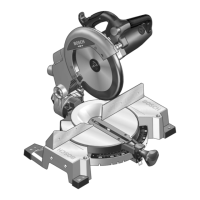English–101 609 929 J60 • (05.12) PS
Variable Horizontal Mitre Angle
The horizontal mitre angle can be set in the range from
45° (left side) to 45° (right side).
Place the power tool in the working position.
Loosen the locking knob 12 in case it is tightened.
Swing up the locking tab 48 under the threaded rod of
the locking knob until it latches (see Figure ). In this
manner, the saw table becomes freely movable.
Rotate the saw table 14 with the locking knob to the
right or left until the angle indicator 49 indicates the re
quired mitre angle.
Retighten the locking knob 12 .
Standard Vertical Bevel Angles
(see Figure
)
The standard angles of 0° and 45° are each provided
by factory adjusted end stops.
Place the power tool in the working position.
Loosen the locking knob 26.
Swing the tool arm with the handle 2 until the tool arm
rests on the stop screw 17 (0°) or 18 (45°).
Retighten the locking knob 26.
Variable Vertical Bevel Angle
The vertical bevel angle can be set in the range from
0° to 45°.
Loosen the locking knob 26.
Swing the tool arm with the handle 2 until the angle in
dicator 50 indicates the required bevel angle (also see
Figure ).
Hold the tool arm in this position and retighten locking
knob 26.
Putting into Operation
Switching On and Off
To put into operation, pull the on/off switch 31 in the
direction of the handle 2.
For safety reasons, the on/off switch of the ma?
chine cannot be locked on but must remain de?
pressed during operation.
The tool arm can be moved downward only by press
ing the button 1.
Therefore in addition to the on/off switch, the button 1
must be pressed for sawing (see Figure ).
To switch off the machine, release the on/off switch
31.
Working Instructions
Before all work on the machine, pull the mains
plug.
General Sawing Instruction
For all cuts, it must first be ensured that
the saw blade at no time can come in con?
tact with the fence, screw clamp or other
machine parts. Remove possible interfer?
ing auxiliary stops or adjust them accord?
ingly.
Protect the saw blade from strikes and shocks. Do not
apply side pressure to the saw blade.
Do not saw warped work pieces. The work piece must
always have a straight edge for resting against the
fence.
Working Table Lighting (Power Light)
(
see Figure
)
Provide adequate lighting for the immediate working
area.
For this purpose, switch on the lighting unit 51 with the
switch 32.
Marking the Cutting Line
(see Figure )
A laser beam shows the cutting line of the saw blade.
In this manner, the work piece can be positioned ex
actly for sawing without opening the swinging guard.
For this option, switch on the laser beam with the
switch 33.
Before sawing, check that the cutting line is correctly
aligned (see "Checking and Adjusting Basic Adjust
ments" Section). The laser beam can become mis
aligned by vibrations from intensive usage, for exam
ple.
Hand Positioning
(see Figure )
Keep fingers, hands and arms away from the rotating
saw blade.
Do not cross your arms when operating the tool arm.
Maximum Work Piece Dimensions
K
L
L
M
Mitre Angle Height x Width [mm]
Mitre
(Horizontal)
Bevel
(Vertical)
At Max.
Height
At Max.
Width
90° 90° 80 x 125 60 x 140
45° 90° 80 x 90 60 x 100
90° 45° 45 x 125 45 x 140
N
O
P
PCM10_WEU.book Seite 10 Donnerstag, 1. Dezember 2005 9:16 09

